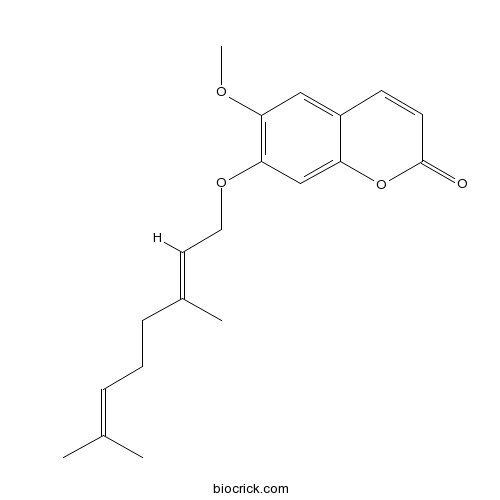7-Geranyloxy-6-methoxycoumarinCAS# 28587-43-1 |

Quality Control & MSDS
3D structure
Package In Stock
Number of papers citing our products

| Cas No. | 28587-43-1 | SDF | Download SDF |
| PubChem ID | 5319406 | Appearance | Powder |
| Formula | C20H24O4 | M.Wt | 328.4 |
| Type of Compound | Coumarins | Storage | Desiccate at -20°C |
| Solubility | Soluble in Chloroform,Dichloromethane,Ethyl Acetate,DMSO,Acetone,etc. | ||
| Chemical Name | 7-[(2E)-3,7-dimethylocta-2,6-dienoxy]-6-methoxychromen-2-one | ||
| SMILES | CC(=CCCC(=CCOC1=C(C=C2C=CC(=O)OC2=C1)OC)C)C | ||
| Standard InChIKey | NLNMITFNBJXRRP-XNTDXEJSSA-N | ||
| General tips | For obtaining a higher solubility , please warm the tube at 37 ℃ and shake it in the ultrasonic bath for a while.Stock solution can be stored below -20℃ for several months. We recommend that you prepare and use the solution on the same day. However, if the test schedule requires, the stock solutions can be prepared in advance, and the stock solution must be sealed and stored below -20℃. In general, the stock solution can be kept for several months. Before use, we recommend that you leave the vial at room temperature for at least an hour before opening it. |
||
| About Packaging | 1. The packaging of the product may be reversed during transportation, cause the high purity compounds to adhere to the neck or cap of the vial.Take the vail out of its packaging and shake gently until the compounds fall to the bottom of the vial. 2. For liquid products, please centrifuge at 500xg to gather the liquid to the bottom of the vial. 3. Try to avoid loss or contamination during the experiment. |
||
| Shipping Condition | Packaging according to customer requirements(5mg, 10mg, 20mg and more). Ship via FedEx, DHL, UPS, EMS or other couriers with RT, or blue ice upon request. | ||
| Description | 1. 7-Geranyloxy-6-methoxycoumarin shows significant cytotoxicity against three cell lines (A549, SMMC-7721 and BALL-1). |
| Targets | HIF |

7-Geranyloxy-6-methoxycoumarin Dilution Calculator

7-Geranyloxy-6-methoxycoumarin Molarity Calculator
| 1 mg | 5 mg | 10 mg | 20 mg | 25 mg | |
| 1 mM | 3.0451 mL | 15.2253 mL | 30.4507 mL | 60.9013 mL | 76.1267 mL |
| 5 mM | 0.609 mL | 3.0451 mL | 6.0901 mL | 12.1803 mL | 15.2253 mL |
| 10 mM | 0.3045 mL | 1.5225 mL | 3.0451 mL | 6.0901 mL | 7.6127 mL |
| 50 mM | 0.0609 mL | 0.3045 mL | 0.609 mL | 1.218 mL | 1.5225 mL |
| 100 mM | 0.0305 mL | 0.1523 mL | 0.3045 mL | 0.609 mL | 0.7613 mL |
| * Note: If you are in the process of experiment, it's necessary to make the dilution ratios of the samples. The dilution data above is only for reference. Normally, it's can get a better solubility within lower of Concentrations. | |||||

Calcutta University

University of Minnesota

University of Maryland School of Medicine

University of Illinois at Chicago

The Ohio State University

University of Zurich

Harvard University

Colorado State University

Auburn University

Yale University

Worcester Polytechnic Institute

Washington State University

Stanford University

University of Leipzig

Universidade da Beira Interior

The Institute of Cancer Research

Heidelberg University

University of Amsterdam

University of Auckland

TsingHua University

The University of Michigan

Miami University

DRURY University

Jilin University

Fudan University

Wuhan University

Sun Yat-sen University

Universite de Paris

Deemed University

Auckland University

The University of Tokyo

Korea University
- 4-Benzoyloxy-2-azetidinone
Catalog No.:BCC8696
CAS No.:28562-58-5
- Theaflavin-3'-gallate
Catalog No.:BCN5421
CAS No.:28543-07-9
- BML-190
Catalog No.:BCC4410
CAS No.:2854-32-2
- 1-Amino-2-methylpropan-2-ol
Catalog No.:BCN1773
CAS No.:2854-16-2
- Anadoline N-oxide
Catalog No.:BCN2029
CAS No.:28513-29-3
- Malvidin-3-O-arabinoside chloride
Catalog No.:BCN3032
CAS No.:28500-04-1
- Petunidin-3-O-arabinoside chloride
Catalog No.:BCN3026
CAS No.:28500-03-0
- Petunidin-3-O-galactoside chloride
Catalog No.:BCN3024
CAS No.:28500-02-9
- Delphinidin-3-O-galactoside chloride
Catalog No.:BCN3019
CAS No.:28500-00-7
- 9-Deacetyltaxinine E
Catalog No.:BCN7227
CAS No.:284672-78-2
- 20-Deacetyltaxuspine X
Catalog No.:BCN7374
CAS No.:284672-76-0
- Tomentin
Catalog No.:BCN5180
CAS No.:28449-62-9
- Persicogenin
Catalog No.:BCN7744
CAS No.:28590-40-1
- Eicosanyl caffeate
Catalog No.:BCN7209
CAS No.:28593-90-0
- Docosyl caffeate
Catalog No.:BCN5182
CAS No.:28593-92-2
- 22-Dehydroclerosteryl acetate
Catalog No.:BCN5183
CAS No.:28594-00-5
- BIRB 796 (Doramapimod)
Catalog No.:BCC2535
CAS No.:285983-48-4
- CCG-1423
Catalog No.:BCC5581
CAS No.:285986-88-1
- Orientin
Catalog No.:BCN4984
CAS No.:28608-75-5
- Isoanhydroicaritin
Catalog No.:BCN3879
CAS No.:28610-30-2
- 8-Prenylkaempferol
Catalog No.:BCN3311
CAS No.:28610-31-3
- Erythristemine
Catalog No.:BCN5184
CAS No.:28619-41-2
- S 14506 hydrochloride
Catalog No.:BCC7174
CAS No.:286369-38-8
- KRN 633
Catalog No.:BCC2544
CAS No.:286370-15-8
Cytotoxic compounds isolated from Murraya tetramera Huang.[Pubmed:25165861]
Molecules. 2014 Aug 27;19(9):13225-34.
A new compound and seven known compounds were isolated from Murraya tetramera Huang for the first time, and they were identified with NMR and MS spectral analysis. It was confirmed that the new compound was 10-methoxy-7-methyl-2H-benzo[g]chromen-2-one (3) and the others were beta-eudesmol (1), trans-3beta-(1-hydroxy-1-methylethyl)-8abeta-methyl-5-methylenedecalin-2-one (2), 5,7-dimethoxy-8-[(Z)-3'-methyl-butan-1',3'-dienyl]coumarin (4), 7-Geranyloxy-6-methoxycoumarin (5), 5,7-dimethoxy-8-(3-methyl-2-oxo-butyl)coumarin (6), murrangatin acetate (7) and toddalenone (8). Furthermore, the cytotoxic activity against human lung adenocarcinoma (A549), human hepatocellular carcinoma cells (SMMC-7721), human bladder tumor cells (EJ), human cervical carcinoma cells (HeLa), and human B-lineage acute lymphoblastic leukemia 1 cells (BALL-1) was evaluated for all compounds. It was found that five of them displayed various degrees of cytotoxicity against different testing targets. Compound 1 showed significant cytotoxic activity against the five cell lines (A549, SMMC-7721, EJ, Hela and BALL-1). Compounds 2 and 5 showed significant cytotoxicity against three cell lines (A549, SMMC-7721 and BALL-1). Compound 4 showed significant cytotoxicity against three cell lines (A549, EJ and BALL-1). However, compound 3 only showed fair cytotoxicity against the BALL-1 cell line. The structure-active relationships were investigated as well. These active compounds might be potential lead compounds for the treatment of cancer.


